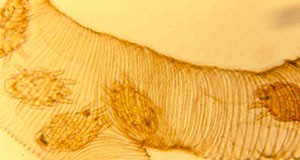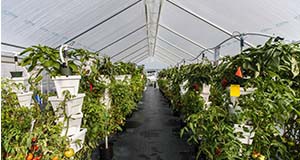
Many small farms are implementing greenhouse hydroponic systems. Perhaps the most challenging aspect of crop management for smaller growers is the control of water and nutrient delivery in a soilless media system. This six-page fact sheet focuses on relatively inexpensive strategies to help small growers know both when to start irrigation events and how long to run a single event when growing in soilless media. Written by Robert C. Hochmuth, Natalie B. Parkell, Wanda L. Laughlin, and Sean C. Rider, and published by the Horticultural Sciences Department.
http://edis.ifas.ufl.edu/hs1274
Category: Small Farms
Pest Identification Guide: An Introduction to Thrips
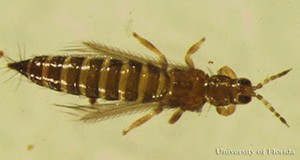 Tiny insects called thrips are difficult to see with the unaided eye but cause very obvious and sometimes ruinous damage to the flowers, buds, and fruit of many important crops. This two-page guide asks and answers the key thrips questions that allow growers to distinguish between chilli thrips, common blossom thrips, and Western flower thrips to more effectively battle against these destructive pests. What does it look like? What is its life cycle? Where is it found? What type of damage does it cause? And, most importantly, who are its natural enemies? Use this guide to help you identify thrips so that you can take effective steps to control them and limit the damage they cause. Written by Nicole Casuso and Hugh Smith with photos by Lyle Buss, Jeff Cluever, Vivek Kumar, P.M.J. Ramakers, Gary Vallad, and Hugh Smith. Published by the Entomology and Nematology Department, UF/IFAS Extension.
Tiny insects called thrips are difficult to see with the unaided eye but cause very obvious and sometimes ruinous damage to the flowers, buds, and fruit of many important crops. This two-page guide asks and answers the key thrips questions that allow growers to distinguish between chilli thrips, common blossom thrips, and Western flower thrips to more effectively battle against these destructive pests. What does it look like? What is its life cycle? Where is it found? What type of damage does it cause? And, most importantly, who are its natural enemies? Use this guide to help you identify thrips so that you can take effective steps to control them and limit the damage they cause. Written by Nicole Casuso and Hugh Smith with photos by Lyle Buss, Jeff Cluever, Vivek Kumar, P.M.J. Ramakers, Gary Vallad, and Hugh Smith. Published by the Entomology and Nematology Department, UF/IFAS Extension.
http://edis.ifas.ufl.edu/in1058
The Social Organization of Honey Bees

A honey bee colony is a superorganism, which means that together its members function like a single animal. Bees within a colony work together like the cells in a human body. They warm the colony in the winter by vibrating their wings to generate heat and cool it in the summer by ferrying in droplets of water and fanning air over them. Worker bees fan air into and out of the colony entrance in distinct inhalations and exhalations. Colonies reproduce by swarming to create new daughter colonies that in turn thermoregulate, breathe, and reproduce just as a single autonomous animal does. In three pages this fact sheet explains the intricate caste system and age-based division of labor that allows colonies of humankind’s best-loved pollinators to function and thrive. Written by Ashley N. Mortensen, Bryan Smith, and James D. Ellis and published by the Entomology and Nematology Department.
http://edis.ifas.ufl.edu/in1102
Small Flock Poultry Nutrition
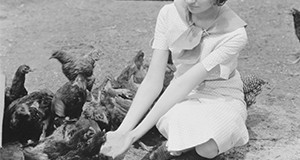
Inadequate poultry nutrition results in substandard growth rates as well as decreased egg production and weight. In order to express the genetic potential for which they were selected, meat- and egg-type birds must receive the correct amounts of nutrients and energy through properly formulated rations. This 4-page fact sheet examines the roles of water, carbohydrates, proteins and amino acids, lipids (fats and oils), vitamins, minerals, and feed additives in poultry growth and development. It also emphasizes the importance of providing suitable feeds to birds of different ages and discusses common feeding mistakes. Written by Michael A. Davis, published by the UF Department of Animal Sciences, and reviewed and revised August 2015. This fact sheet is a major revision of “Small Poultry Flock Nutrition,” written by B. L. Damron and D. R. Sloan, April 1998.
http://edis.ifas.ufl.edu/ps033
Value-Added Products for Fresh Highbush Blueberries
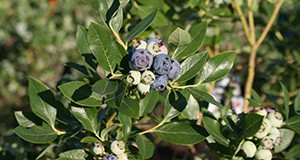
Blueberries are one of the most popular fruits worldwide. Blueberries’ health benefits have fueled this popularity, and today, blueberries can be found in products ranging from nutritional supplements to pet food. This 4-page fact sheet covers the processing methods such as freezing or drying that transform fresh blueberries into ingredients that can be used in other products. Written by Ruiqi Li and Liwei Gu, and published by the UF Food Science and Human Nutrition Department, June 2015.
http://edis.ifas.ufl.edu/fs268
Eight Steps to Developing a Simple Marketing Plan

Marketing is an essential component of any business, including agriculture. Despite the important role of marketing, many smallholding operators/growers are reluctant to create a marketing plan. This 5-page fact sheet provides a rationale for developing a marketing plan, a step-by-step process for creating one, and a marketing plan worksheet. Written by Edward A. Evans and Fredy H. Ballen, and published by the UF Department of Food and Resource Economics, August 2015. (Photo credit: iStock/Thinkstock)
http://edis.ifas.ufl.edu/fe967
How to Dissect Honey Bees (Apis mellifera L.) to Detect Tracheal Mites (Acarapis woodi Rennie)
Tracheal mites are parasites of the western honey bee and negatively impact the health and productivity of an infested colony. This 6-page fact sheet details the method of dissecting honey bees in order to diagnose tracheal mites. Written by John Bonkowski, Ashley N. Mortensen, and James D Ellis, and published by the UF Department of Entomology and Nematology, January 2015.
http://edis.ifas.ufl.edu/in1072
Observation Bee Hives
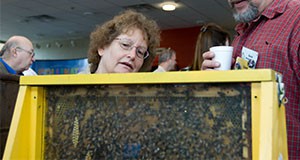
The use of observation bee hives continues to interest a variety of people. This is not surprising. The observation hive is one of the primary research and educational tools in apiculture. It is both educational and entertaining. Observation bee hives can be used to enhance public relations and marketing programs. But a great deal of time and energy is needed to set up a hive and keep it going. Maintenance can be expensive and time consuming, especially if the hive is to be used as a permanent display for the general public. This 3-page fact sheet provides sources for building observation hives and tips for maintenance. Written by David Hall, James D. Ellis, and Malcolm Sanford, and published by the UF Department of Entomology and Nematology, March 2015. (UF/IFAS photo by Tyler Jones)
http://edis.ifas.ufl.edu/mg320
Sample Pollination Agreement
 The key to a prospering pollination service is proper promotion, honest, quality service, and a written contract. This contract would detail the expectations of both the beekeeper and the grower. This 4-page fact sheet provides a suggested pollination agreement. Written by Malcolm T. Sanford, Jeanette Klopchin, and James Ellis, and published by the UF Department of Entomology and Nematology, March 2015. (UF/IFAS Photo: Thomas Wright)
The key to a prospering pollination service is proper promotion, honest, quality service, and a written contract. This contract would detail the expectations of both the beekeeper and the grower. This 4-page fact sheet provides a suggested pollination agreement. Written by Malcolm T. Sanford, Jeanette Klopchin, and James Ellis, and published by the UF Department of Entomology and Nematology, March 2015. (UF/IFAS Photo: Thomas Wright)
http://edis.ifas.ufl.edu/aa169
Zombie Fly (suggested common name) Apocephalus borealis Brues (Insecta: Diptera: Phoridae)
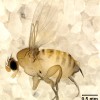 The zombie fly is primarily a parasitoid of bumble bees and wasps in North America. In 2012, Dr. John Hafernik and his colleagus at San Francisco State University discovered that Apocephalus borealis also parasitizes honey bees. Parasitized honey bees show zombie-like behavior by leaving their hives at night and are often attracted to nearby lights where they show disoriented behavior and die in a few hours. This 5-page fact sheet was written by Nicole A. Casuso, Ashley N. Mortensen, and James D. Ellis, and published by the UF Department of Entomology and Nematology, October 2014. (Photo: Jessica Andrieux, CC SA-BY 2.5)
The zombie fly is primarily a parasitoid of bumble bees and wasps in North America. In 2012, Dr. John Hafernik and his colleagus at San Francisco State University discovered that Apocephalus borealis also parasitizes honey bees. Parasitized honey bees show zombie-like behavior by leaving their hives at night and are often attracted to nearby lights where they show disoriented behavior and die in a few hours. This 5-page fact sheet was written by Nicole A. Casuso, Ashley N. Mortensen, and James D. Ellis, and published by the UF Department of Entomology and Nematology, October 2014. (Photo: Jessica Andrieux, CC SA-BY 2.5)
http://edis.ifas.ufl.edu/in1063
Health Benefits and Medicinal Value of Honey
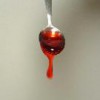 Honey has been used for medicinal purposes for thousands of years. It is rich in sugars such as glucose and fructose, but it also contains small amounts of vitamins, minerals, amino acids, and antioxidants such as phenolic acids and flavonoids. These nutrients help to make honey a unique, natural health product. Its market niche as a health product is growing, and current research supports the potential of honey as a medicinal product. This 3-page fact sheet describes health aspects of honey deriving from the floral source and color, beneficial compounds, anti-microbial properties and anti-inflammatory properties. Written by Sara Marshall, Liwei Gu, and Keith R. Schneider, and published by the UF Department of Food Science and Human Nutrition, April 2015.
Honey has been used for medicinal purposes for thousands of years. It is rich in sugars such as glucose and fructose, but it also contains small amounts of vitamins, minerals, amino acids, and antioxidants such as phenolic acids and flavonoids. These nutrients help to make honey a unique, natural health product. Its market niche as a health product is growing, and current research supports the potential of honey as a medicinal product. This 3-page fact sheet describes health aspects of honey deriving from the floral source and color, beneficial compounds, anti-microbial properties and anti-inflammatory properties. Written by Sara Marshall, Liwei Gu, and Keith R. Schneider, and published by the UF Department of Food Science and Human Nutrition, April 2015.
http://edis.ifas.ufl.edu/fs267
Robbing Behavior in Honey Bees
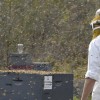 Western honey bee workers can invade and steal honey/nectar from other colonies or sugar/corn syrup from feeders used to deliver syrup to other colonies. This is called “robbing” behavior. Robbing behavior typically involves the collection of nectar and honey, but not pollen or brood. Some beekeepers report that robbing bees may steal wax or propolis from other hives, but there is not much data available on this occurrence. Robbing behavior can escalate quickly from just a few bees robbing other colonies to a massive frenzy of bees robbing many colonies in an apiary. This 3-page fact sheet was written by Ryan Willingham, Jeanette Klopchin, and James Ellis, and published by the UF Department of Entomology and Nematology, February 2015. (Photo Credit: UF/HBREL)
Western honey bee workers can invade and steal honey/nectar from other colonies or sugar/corn syrup from feeders used to deliver syrup to other colonies. This is called “robbing” behavior. Robbing behavior typically involves the collection of nectar and honey, but not pollen or brood. Some beekeepers report that robbing bees may steal wax or propolis from other hives, but there is not much data available on this occurrence. Robbing behavior can escalate quickly from just a few bees robbing other colonies to a massive frenzy of bees robbing many colonies in an apiary. This 3-page fact sheet was written by Ryan Willingham, Jeanette Klopchin, and James Ellis, and published by the UF Department of Entomology and Nematology, February 2015. (Photo Credit: UF/HBREL)
http://edis.ifas.ufl.edu/in1064
Wedge-Shaped Beetles (suggested common name) Ripiphorus spp. (Insecta: Coleoptera: Ripiphoridae)
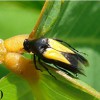 Ripiphoridae are a family of unusual parasitic beetles that are thought to be related to tumbling flower beetles and blister beetles. They parasitize bees and wasps, roaches, and wood-boring beetles, but specific hosts for many ripiphorid species are unknown. Their secretive life cycle makes an assessment of their economic and ecological impact very difficult. Additional research is necessary to determine the abundance and impact of Ripiphorus species. This 4-page fact sheet was written by David Owens, Ashley N. Mortensen, Jeanette Klopchin, William Kern, and Jamie D. Ellis, and published by the UF Department of Entomology and Nematology, December 2014.
Ripiphoridae are a family of unusual parasitic beetles that are thought to be related to tumbling flower beetles and blister beetles. They parasitize bees and wasps, roaches, and wood-boring beetles, but specific hosts for many ripiphorid species are unknown. Their secretive life cycle makes an assessment of their economic and ecological impact very difficult. Additional research is necessary to determine the abundance and impact of Ripiphorus species. This 4-page fact sheet was written by David Owens, Ashley N. Mortensen, Jeanette Klopchin, William Kern, and Jamie D. Ellis, and published by the UF Department of Entomology and Nematology, December 2014.
http://edis.ifas.ufl.edu/in1069
How Do I Legally Sell Meat from Alligators, Wild Game, or My Farmed Game or Birds in Florida?
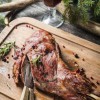 Game meats provide wholesome and nutritious animal protein, but learning the regulations (and which agency has jurisdiction over which regulations) can be burdensome for those who want to be entrepreneurial. This 4-page fact sheet is a “one-stop-shop” for Florida residents who want to sell products from alligators, wild game, or their own farmed game or birds. Written by Chad Carr, Jason Scheffler, Larry Eubanks, Ron Webb, Lee Cornman, Scotland Talley, and Steve Stiegler, and published by the UF Department of Animal Sciences, December 2014. (Photo: iStock/Thinkstock.com)
Game meats provide wholesome and nutritious animal protein, but learning the regulations (and which agency has jurisdiction over which regulations) can be burdensome for those who want to be entrepreneurial. This 4-page fact sheet is a “one-stop-shop” for Florida residents who want to sell products from alligators, wild game, or their own farmed game or birds. Written by Chad Carr, Jason Scheffler, Larry Eubanks, Ron Webb, Lee Cornman, Scotland Talley, and Steve Stiegler, and published by the UF Department of Animal Sciences, December 2014. (Photo: iStock/Thinkstock.com)
http://edis.ifas.ufl.edu/an315
Facts about Farm to School
 Farm to school is a nationwide program that improves the supply of fresh, local produce to schools by building relationships between local farmers and schools. Over the past 20 years, school districts in all 50 states have joined the F2S program and are purchasing items from local farmers. Recent requirements for more fruit and vegetables in the National School Lunch Programs have made the F2S program more popular than ever. The University of Florida is committed to the Farm to School program and is working closely with the Florida Department of Agriculture and Consumer Services to connect farmers to schools. This 3-page fact sheet was written by Samantha Ward, Lauren Headrick, and Karla Shelnutt, and published by the UF Department of Family Youth and Community Sciences, December 2014. (Photo: iStock/Thinkstock.com)
Farm to school is a nationwide program that improves the supply of fresh, local produce to schools by building relationships between local farmers and schools. Over the past 20 years, school districts in all 50 states have joined the F2S program and are purchasing items from local farmers. Recent requirements for more fruit and vegetables in the National School Lunch Programs have made the F2S program more popular than ever. The University of Florida is committed to the Farm to School program and is working closely with the Florida Department of Agriculture and Consumer Services to connect farmers to schools. This 3-page fact sheet was written by Samantha Ward, Lauren Headrick, and Karla Shelnutt, and published by the UF Department of Family Youth and Community Sciences, December 2014. (Photo: iStock/Thinkstock.com)
http://edis.ifas.ufl.edu/fy1450
Frequently Asked Questions about the Africanized Honey Bee in Florida
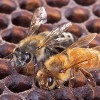 The African honey bee, Apis mellifera scutellata, was introduced into South America from the central and southern part of Africa in 1957. Since its introduction into South America, the African bee has migrated into the southwestern United States and Florida. Apis mellifera scutellata is the African bee subspecies referred to in this 3-page fact sheet, which answers commonly asked questions about these bees and their behavior. Written by M. K. O’Malley, J. D. Ellis and A. S. Neal, and published by the UF Department of Entomology and Nematology, November 2014.
The African honey bee, Apis mellifera scutellata, was introduced into South America from the central and southern part of Africa in 1957. Since its introduction into South America, the African bee has migrated into the southwestern United States and Florida. Apis mellifera scutellata is the African bee subspecies referred to in this 3-page fact sheet, which answers commonly asked questions about these bees and their behavior. Written by M. K. O’Malley, J. D. Ellis and A. S. Neal, and published by the UF Department of Entomology and Nematology, November 2014.
http://edis.ifas.ufl.edu/in738
Best Management Practices for Siting Honey Bee Colonies: Good Neighbor Guidelines
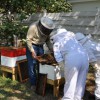 Keeping honey bees requires responsible management so that the bees do not become a nuisance. Additionally, the presence of Africanized honey bees in Florida places more pressure on beekeepers to maintain their colonies properly. This 3-page fact sheet is a reference for honey bee management in Florida, with emphasis on siting apiaries in sensitive locations, in order to promote harmonious cooperation between beekeepers, neighbors, and landowners. Written by Jamie Ellis, Jerry Hayes, and published by the UF Department of Entomology and Nematology, November 2014. (Photo by Thien Gretchen (CC BY-NC-ND 2.0), via Flickr)
Keeping honey bees requires responsible management so that the bees do not become a nuisance. Additionally, the presence of Africanized honey bees in Florida places more pressure on beekeepers to maintain their colonies properly. This 3-page fact sheet is a reference for honey bee management in Florida, with emphasis on siting apiaries in sensitive locations, in order to promote harmonious cooperation between beekeepers, neighbors, and landowners. Written by Jamie Ellis, Jerry Hayes, and published by the UF Department of Entomology and Nematology, November 2014. (Photo by Thien Gretchen (CC BY-NC-ND 2.0), via Flickr)
http://edis.ifas.ufl.edu/aa137
Outbreaks of Foodborne Illness Associated with Melons
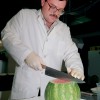 Despite the manner in which they are prepared, melons are commonly consumed raw without a processing step which would eliminate pathogenic bacteria. For those concerned about the safety of melons, including cantaloupe, honeydew, and watermelon, this 6-page fact sheet lists outbreaks associated with melons in the United States, Canada, and Europe, along with information about the location, pathogen, and incidence of illness. Written by Michelle D. Danyluk, Rachel McEgan, Ashley N. Turner, and Keith R. Schneider, and published by the UF Department of Food Science and Human Nutrition, November 2014. (UF/IFAS Photo by Thomas Wright)
Despite the manner in which they are prepared, melons are commonly consumed raw without a processing step which would eliminate pathogenic bacteria. For those concerned about the safety of melons, including cantaloupe, honeydew, and watermelon, this 6-page fact sheet lists outbreaks associated with melons in the United States, Canada, and Europe, along with information about the location, pathogen, and incidence of illness. Written by Michelle D. Danyluk, Rachel McEgan, Ashley N. Turner, and Keith R. Schneider, and published by the UF Department of Food Science and Human Nutrition, November 2014. (UF/IFAS Photo by Thomas Wright)
http://edis.ifas.ufl.edu/fs258
Talking Local series
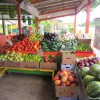 Extension agents can assist Florida farmers and ranchers in the labeling, sale, and promotion of locally-produced products. This six part series of 3- to 5-page fact sheets provides information about Florida consumers’ perceptions of local food to Extension faculty who are interested in local food programming or who work with local food clientele. Written by Joy N. Rumble and Caroline G. Roper, and published by the UF Department of Agricultural Education and Communication, September 2014.
Extension agents can assist Florida farmers and ranchers in the labeling, sale, and promotion of locally-produced products. This six part series of 3- to 5-page fact sheets provides information about Florida consumers’ perceptions of local food to Extension faculty who are interested in local food programming or who work with local food clientele. Written by Joy N. Rumble and Caroline G. Roper, and published by the UF Department of Agricultural Education and Communication, September 2014.
http://edis.ifas.ufl.edu/topic_series_talking_local
In this series:
- Florida Consumer Definitions of Local Food
- Florida Consumers’ Local Food Purchasing Behaviors
- Florida Consumers’ Reasons for Purchasing Local Food
- Florida Consumers’ Food Buying Decisions when Given Local Food Information
- Florida Consumers’ Flexibility with the Term “Local”
- Florida Consumers’ Fresh from Florida Perceptions
Tropilaelaps mite Tropilaelaps spp. Delfinado & Baker (Arachnida: Mesostigmata: Laelapidae)
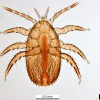 Honey bees throughout the world are exposed to numerous pests, parasites, and pathogens. One such parasite is Tropilaelaps spp. Delfinado & Baker, an ectoparasitic mite that feeds on the hemolymph of developing honey bees. Four species of Tropilaelaps have been identified and characterized. This 4-page fact sheet was written by Ashley N. Mortensen, Sarah Burleson, Gunasegaran Chelliah, Ken Johnson, Daniel R. Schmehl, and Jamie D. Ellis, and published by the UF Department of Entomology and Nematology, October 2014. (Photo credit: Pest and Diseases Image Library, Bugwood.org)
Honey bees throughout the world are exposed to numerous pests, parasites, and pathogens. One such parasite is Tropilaelaps spp. Delfinado & Baker, an ectoparasitic mite that feeds on the hemolymph of developing honey bees. Four species of Tropilaelaps have been identified and characterized. This 4-page fact sheet was written by Ashley N. Mortensen, Sarah Burleson, Gunasegaran Chelliah, Ken Johnson, Daniel R. Schmehl, and Jamie D. Ellis, and published by the UF Department of Entomology and Nematology, October 2014. (Photo credit: Pest and Diseases Image Library, Bugwood.org)
http://edis.ifas.ufl.edu/in1061
